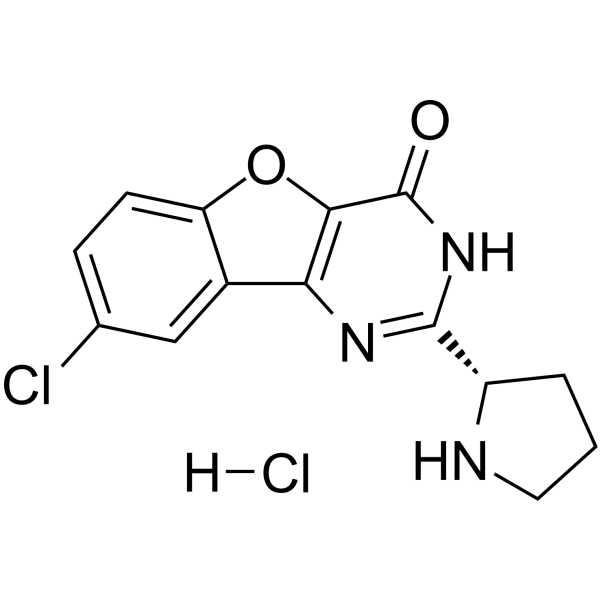
XL413 (hydrochloride)
CAS No. 2062200-97-7
XL413 (hydrochloride)( —— )
Catalog No. M25037 CAS No. 2062200-97-7
XL413 inhibits the growth of MDA-MB-231T and COLO 205 cells (IC50s = 118 and 140 nM, respectively) and reduces tumor growth in a COLO 205 mouse xenograft model.
Purity : >98% (HPLC)
 COA
COA
 Datasheet
Datasheet
 HNMR
HNMR
 HPLC
HPLC
 MSDS
MSDS
 Handing Instructions
Handing Instructions
| Size | Price / USD | Stock | Quantity |
| 5MG | 105 | In Stock |


|
| 10MG | 147 | In Stock |


|
| 25MG | 267 | In Stock |


|
| 50MG | 447 | In Stock |


|
| 100MG | 672 | In Stock |


|
| 200MG | 888 | In Stock |


|
| 500MG | 1368 | In Stock |


|
| 1G | Get Quote | In Stock |


|
Biological Information
-
Product NameXL413 (hydrochloride)
-
NoteResearch use only, not for human use.
-
Brief DescriptionXL413 inhibits the growth of MDA-MB-231T and COLO 205 cells (IC50s = 118 and 140 nM, respectively) and reduces tumor growth in a COLO 205 mouse xenograft model.
-
DescriptionXL413 is a potent inhibitor of Cdc7 (IC50 = 3.4 nM). It is >60, >10, and >300-fold selective for Cdc7 over CK2, PIM1, and a panel of over 100 protein kinases, respectively. XL413 inhibits the growth of MDA-MB-231T and COLO 205 cells (IC50s = 118 and 140 nM, respectively). It inhibits Cdc7-specific phosphorylation of mini-chromosome maintenance protein (MCM2) and induces cell cycle accumulation in the S and G2 phases in MDA-MB-231T and COLO 205 cells that overexpress Cdc7. In vivo, XL413 inhibits MCM2 phosphorylation (ED50 = <3 mg/kg) and reduces tumor growth in a COLO 205 mouse xenograft model when administered orally at doses of 10, 30, and 100 mg/kg.
-
In VitroXL413 (BMS-863233) hydrochloride inhibits the cell proliferation (IC50=2685 nM), decreases cell viability (IC50=2142 nM) and elicits the caspase 3/7 activity (EC50=2288 nM) in Colo-205 cells. XL413 hydrochloride also significantly inhibits the anchorage-independent growth of colo-205 in soft agar (IC50=715 nM). XL413 hydrochloride shows cytotoxic effects on tumors, with IC50 of 22.9 μM in HCC1954 cells and 1.1 μM in Colo-205 cells. XL413 hydrochloride induces apoptosis in the Colo-205 cells, but not in HCC1954 cells. XL413 is effective DDK inhibitors in vitro, with IC50 of 22.7 nM. XL413 hydrochloride is defective in inhibiting DDK-dependent Mcm2 phosphorylation in HCC1954 cells but is effective in Colo-205 cells.
-
In VivoXL413 (BMS-863233; 100 mg/kg, p.o.) hydrochloride shows excellent plasma exposures in mice and possesses good PK properties. XL413 (10, 30, or 100 mg/kg, p.o.) hydrochloride is well tolerated at all the doses, with no significant body weight loss.
-
Synonyms——
-
PathwayOthers
-
TargetOther Targets
-
Recptor——
-
Research Area——
-
Indication——
Chemical Information
-
CAS Number2062200-97-7
-
Formula Weight326.2
-
Molecular FormulaC14H12ClN3O2 ? HCl
-
Purity>98% (HPLC)
-
SolubilityH2O : 10 mg/mL (30.66 mM; Need ultrasonic);DMSO : 3.4 mg/mL (10.42 mM; Need ultrasonic and warming)
-
SMILESO=C1N=C([C@@H]2CCCN2)NC3=C1OC4=C3C=C(Cl)C=C4.Cl
-
Chemical Name——
Shipping & Storage Information
-
Storage(-20℃)
-
ShippingWith Ice Pack
-
Stability≥ 2 years
Reference
molnova catalog



related products
-
Tau-aggregation and ...
Tau-aggregation and neuroinflammation-IN-1 is a potent inhibitor of tau protein aggregates, showing significant inhibitory activity against AcPHF6 and full-length tau protein aggregates.
-
Caspase 2 Substrate ...
Caspase 2 Substrate 1m (ICH-1), fluorogenic; Ac-VDVAD-AMC
-
Laminin (925-933)(TF...
Laminin (925-933) (TFA) is a peptide derived from residues 925-933 of the Laminin B1 chain that binds to the laminin receptor.



 Cart
Cart
 sales@molnova.com
sales@molnova.com


